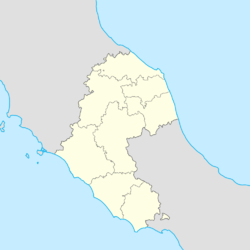Roman Republic (18th century)
| Roman Republic | ||||||||||||||
| Repubblica Romana | ||||||||||||||
| Client state of France | ||||||||||||||
| ||||||||||||||
|
| ||||||||||||||
 Departments of the Roman Republic in 1798. | ||||||||||||||
| Capital | Rome | |||||||||||||
| Languages | Italian | |||||||||||||
| Government | Directorial republic | |||||||||||||
| Directory | ||||||||||||||
| • | 1798–99 | Roman Directory | ||||||||||||
| Legislature | Legislative Council | |||||||||||||
| Historical era | French Revolutionary Wars | |||||||||||||
| • | French invasion | 15 February 1798 | ||||||||||||
| • | Neapolitan invasion | 30 September 1799 | ||||||||||||
| Currency | Roman scudo, Roman baiocco | |||||||||||||
| ||||||||||||||
| Today part of | | |||||||||||||
The Roman Republic (Italian: Repubblica Romana) was proclaimed on 15 February 1798 after Louis Alexandre Berthier, a general of Napoleon, had invaded the city of Rome on 10 February. The Roman Republic was a client republic under the French Directory composed of territory conquered from the Papal States. Pope Pius VI was exiled to France and died there in 1799. It immediately took the control of the other two former-papal revolutionary administrations, the Tiberina Republic and the Anconine Republic. The Roman Republic was short-lived, as the Papal States were restored in October 1799.
Annexation of Rome
Napoleon's campaign on the Italian peninsula from 1796 to 1797 was one of the reasons for his elevation to supreme commander of the French Army during the Wars of the Republic. After the creation of the First Coalition (Holy Roman Empire, Britain, Prussia, Spain, Naples, etc.) in 1792, Napoleon Bonaparte intended to take the fight to the coalition in Northern Italy to force the Austrians to the negotiating table via an invasion of Piedmont. At the same time he intended to reinforce the French Army of Italy, which was outnumbered by Austria and the Italian States. This invasion of the Italian Peninsula was also a diversion since, according to the First Coalition, the main offensive was expected in the Rhine River. Rome, under the rule of the Papal States, was part of the First Coalition, along with many other Italian states.
After crossing the Alps in April 1796 and defeating the Piedmontese army on 12 April 1796 in the Battle of Montenotte and on 21 April 1796 in the Battle of Mondovi, Bonaparte turned his attention south of Piedmont to deal with the Papal States. Bonaparte, skeptical over divided command for the invasion, sent two letters to the Directory. The letters let the Directory relent the invasion for a while. The Austrians were defeated at the Battle of Lodi on 10 May 1796 and retreated to Minico. Under the Treatry of Tolentino, signed on 19 February 1797, Rome was forced to accept an ambassador of the French Republic.[1] In February 1798, the French invaded the Papal States, motivated by the killing of French general Mathurin-Léonard Duphot in December 1797. After the successful invasion, the Papal States became a satellite state renamed the Roman Republic, under the leadership of Louis-Alexandre Berthier, one of Bonaparte's generals.[2] Pope Pius VI was taken prisoner, escorted out of Rome on 20 February 1798 and exiled to France, where he would later die.
However, the republic did not last long and popular support for it was low. Following a Neapolitan invasion on 30 September 1799, the Papal States were restored under Pope Pius VII in June 1800.[3] The French invaded the Papal States again in 1808, after which it was divided between France and the Kingdom of Italy until the end of the Napoleonic Wars in 1815.
Government
The Republic's government was based on that of the more famous namesake Roman Republic; a Senate. The government was run by the senators, each one representing a different political party. The Senate was basically a Parliament. The main purpose of the Senate was to provide a chamber of "second thought" to consider legislation passed by a lower house, whose members are usually elected.
Flag
The Roman Republic flag was a vertical tricolour black-white-red, taken from the French tricolour, as granted by Napoleon. It was governed by a clique of consuls, like the ancient Roman Republic. French forces had invaded the Papal States partly in revenge for the death of French general Mathurin-Léonard Duphot in 1797.
In popular culture
In the opera Tosca by Giacomo Puccini the character Angelotti is called "consul of the deceased Roman Republic" (the plot takes place in 1800; Angelotti escapes the papal prison); he is a fictional character although his name evokes that of the consul Liborio Angelucci.
See also
References
- ↑ Imperial City: Rome under Napoleon, Susan Vandiler, {pp.20}
- ↑ "Napoleon's Campaign in Italy, 1796-97".
- ↑ Imperial City: Rome under Napoleon, Susan Vandliver, {pp.21}
- www.historyofwar.org/articles/campaign_napoleon_italy_1796.html
- Imperial City: Rome under Napoleon, Susan Vandiver Nicassio, (October 15, 2009, University of Chicago Press), {pp. 20 to 21}

